
views
X
Research source
Once you’ve determined what kind of fertilizer you need, buy some from a local store or online retailer. Use the fertilizer correctly to offer the maximum benefit to your plants.
Choosing the Right Fertilizer

Test your soil’s pH and nutrient levels. Before selecting an organic dry fertilizer, use a soil testing kit to find out what kinds of amendments your soil needs. Buy a home soil test kit from your local garden center, or send a sample to a soil testing lab near you. Use a test kit or request a lab test that shows both soil pH and nutrient levels. Many universities offer soil pH and nutrient analysis through their agricultural departments. Do a search for “soil testing lab near me” to find the most convenient place to send your sample.
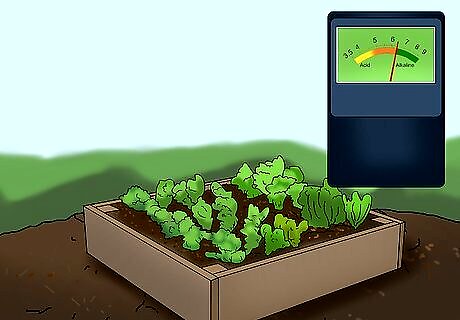
Find out what soil pH is best for your plants. Some plants are happiest in more acidic soils, while others prefer an alkaline environment. Once you’ve determined the pH level of your soil, research the needs of the plants you plan to grow. You can use a variety of organic products to amend the pH of your soil, if necessary. Ask at your local garden center or do a search online to find out what pH levels your plants prefer. If you need to make your soil less acidic, amend your soil with calcium-rich materials like clam or oyster shells, ground shell marl, wood ash, gypsum, or dolomite. You can make your soil more acidic by adding organic mulches or sphagnum peat moss. If you're just starting out with gardening, it may be easier to choose plants that will grow well with your soil's current pH instead of changing it.

Get fertilizers that match your soil’s nutrient needs. If your soil is deficient in any major nutrients, look for organic fertilizers that can make up for those deficiencies. At the most basic level, all plants need nitrogen (N), phosphorus (P), and potassium (K) to thrive. Different fertilizers contain different quantities of these nutrients. Nitrogen-rich fertilizers include urea, feathers, blood meal, bat guano, manures, and fish emulsion. If your soil needs more phosphorus, use a fertilizer such as rock phosphate, bone meal, or colloidal phosphate. Kelp, wood ash, granite meal, and greensand can all boost your soil’s potassium content. If you need a combination of nutrients, you can purchase different fertilizers and combine them according to your needs.
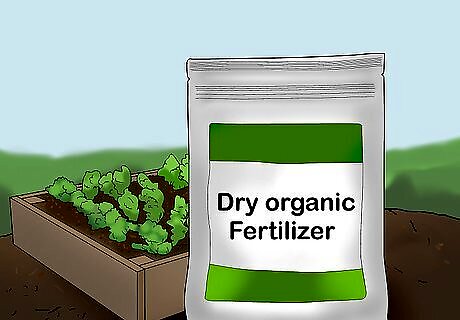
Buy a dry organic fertilizer blend for a mixture of nutrients. There are a variety of pre-made blends of dry organic fertilizing components on the market. In each blend, the components are dispersed evenly through the mixture, ensuring that each handful contains roughly the same concentration of nutrients. Each blend also uses different components, however, so it is important that you check the label to find out which components are used.
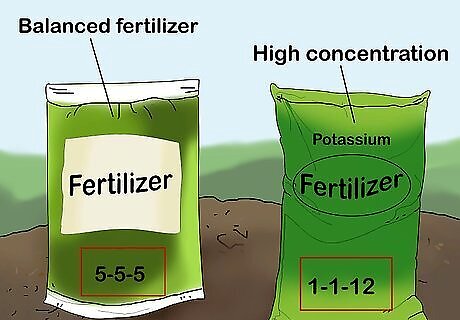
Check the number on the label to determine the nutrient balance. All fertilizers, whether chemical or organic, are labeled with a 3-part number that indicates the concentration of nitrogen, phosphorus, and potassium, respectively. For example, if you need a balanced fertilizer, look for one with a 5-5-5 or 10-10-10 label. If your soil is deficient in one nutrient, such as potassium, look for a fertilizer with a label that indicates a high concentration of the missing nutrient (e.g., 1-1-12).
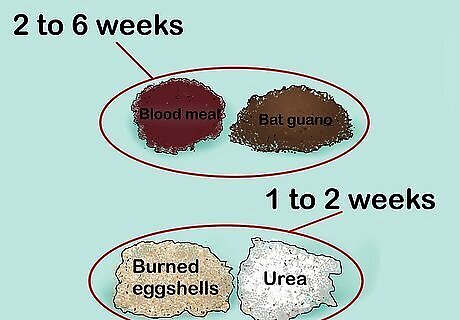
Plan for a slow nutrient release rate. Organic fertilizers need time to decompose before they can release their nutrients into the soil. They may be especially slow to decompose in cold or dry conditions, when microbial activity levels are low. Plan ahead to determine when you need to add your fertilizer to the soil in order to get the maximum benefits for your plants. Blood meal, bat guano, and manure-based fertilizers tend to release their nutrients fairly gradually, over a period of 2-6 weeks. Burned eggshells and urea are relatively fast-acting fertilizers, delivering their nutrients within 1-2 weeks. Fertilizers that release their nutrients quickly may need to be applied more often than those that act slowly, depending on your plants’ needs.
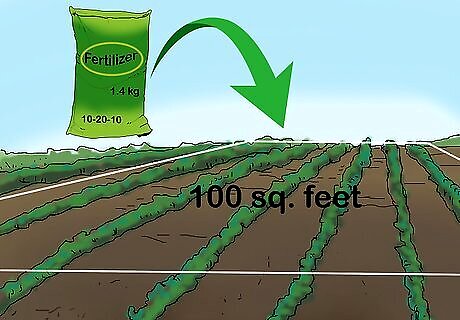
Measure your garden to determine how much fertilizer you need. The amount of fertilizer you will need depends on several factors, including the type of fertilizer you are using, the quality of your soil, and the needs of your plants. Knowing the size of the area you plan to fertilize is also critical. With the size of your garden or planting area in mind, check the label on your fertilizer for recommendations on how much to use per square foot or square meter. For example, it is generally safe to use 2-3 pounds (0.9-1.4 kg) of 10-20-10 fertilizer per 100 square feet (9.3 sq. m.) of soil. Fertilizers with a higher nitrogen content should be used more sparingly, since too much nitrogen can damage plants. Potted plants generally need to be fertilized more often than plants grown in the ground, but fertilizer must be applied lightly to avoid injuring the plant. Check the fertilizer label or consult with a gardening expert to determine how much fertilizer to give potted plants.
Finding Organic Fertilizers

Go to an organic garden supply center. Organic garden centers specialize in organic products and will have the biggest, highest quality selection of organic dry fertilizers to choose from. You could also try a general garden center, as many of these will carry some organic dry fertilizers. They will probably have a more limited selection than an organic supply center, however. Do a search for “organic garden supply center near me.” If you’re not sure what kinds of fertilizers to buy, bring the results of a soil test and talk to a garden supply store employee about which fertilizers are best for your needs.
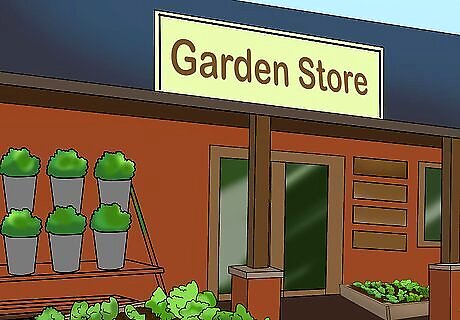
Try a major retail home and garden store. The availability of home and garden chains is a definite plus, since you can find a store within a short drive of nearly any city. The low cost offered by many of these stores is another positive. On the downside, you may have trouble finding a wide selection of organic dry fertilizers to choose from, and you may not be able to find one that suits your garden’s specific needs.
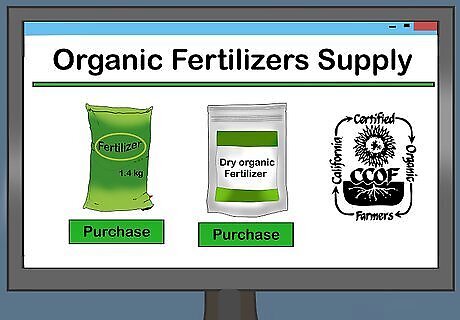
Purchase organic fertilizers online. If you can’t find a store that suits your needs locally, do a web search for retailers that sell organic garden supplies. If you have questions about the products or need help deciding what to buy, most retailers list customer service contact numbers or email addresses on their websites. If you’re concerned about the quality of the ingredients offered by an online store, find out if they are a certified retailer of organic supplies. For example, check to see if the store is certified by an organization like California Certified Organic Farmers (CCOF). You can also look at online reviews and check the store’s rating with consumer protection agencies such as the Better Business Bureau.
Using Organic Dry Fertilizer Correctly
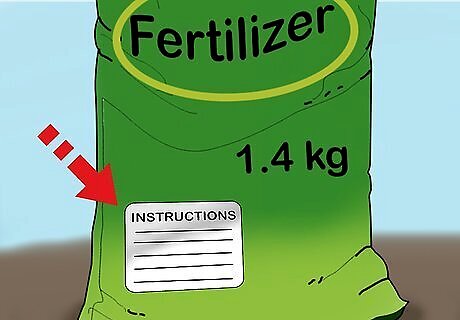
Follow the instructions on the label. Different organic fertilizers work at different rates and interact with plants and the soil in different ways. Before adding any type of fertilizer to your soil or plants, check the label on the package for specific instructions on how much to apply and how often to apply it.
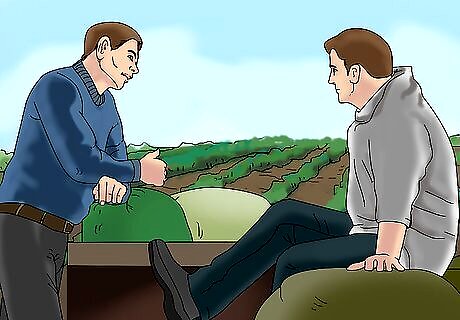
Get advice from a gardening specialist. An employee at your favorite nursery or garden supply store may have helpful advice on how to get the most out of your organic fertilizers. Tell them about your soil’s current pH and nutrient levels, what kinds of plants you want to grow, and when you intend to start planting. Ask for specific advice about when and how to apply fertilizers.
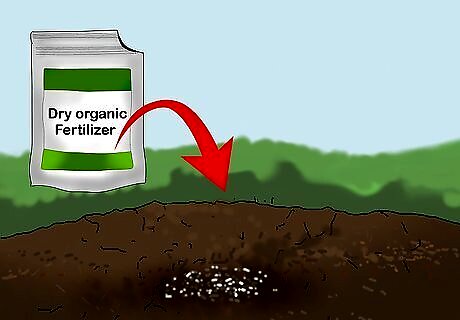
Add fertilizer to your soil before planting. In general, organic dry fertilizer works best if you work it into the soil before adding your plants. Sprinkle the desired amount of fertilizer onto the ground where you intend to do your planting, then use a hoe, rake, or tiller to mix the fertilizer into the top 4-6 inches (10-15 cm) of soil. Since organic fertilizers are usually gentler on plants then their synthetic counterparts, you can also add small amounts of fertilizer directly to planting holes before planting seeds or seedlings.

Feed your established plants occasionally, if needed. Depending on your plants’ needs and how fast-acting your fertilizers are, it may be helpful to give your plants a boost by occasionally adding a little more fertilizer to the soil. Side dress your plants by sprinkling a little fertilizer on the soil or in a shallow furrow around the base of each plant, or between rows of plants. For best results, do not apply the fertilizer directly to the base of the plant. Instead, place the fertilizer just outside the plant’s “drip line” (the outermost circumference of the widest part of the plant’s foliage).



















Comments
0 comment